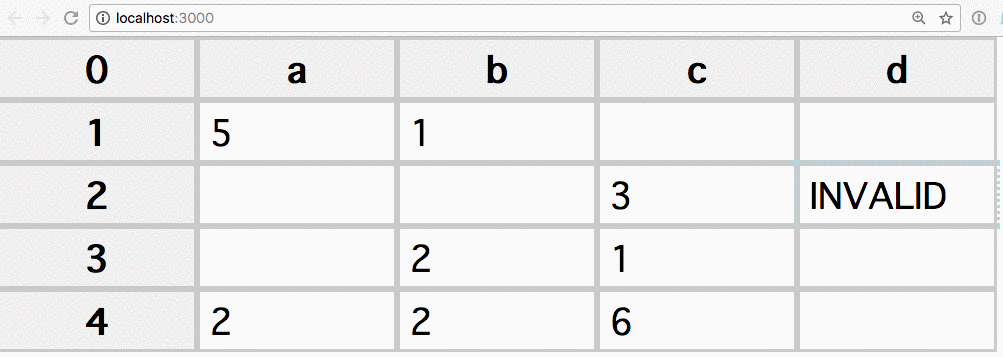Spreadsheet
This repo contains the code powering a simple spreadsheet-like React component.
Demo
How to run the code
Unzip an run
yarn
to fetch the dependencies, and
yarn start
will run and open the app in the default browser on port 3000.
How to run the tests
The application has tests written using uses jest + enzyme.
With jest installed globally (yarn global add jest), the tests can be run by executing
yarn test
from the root of the project.
Description
The code is based on create-react-app.
A Table is a reusable component that hosts a number of cells.
The exact number of columns and cells can be specified at creation time.
A Table renders a list of y Row components, which in turn render x Cell components each.
In the current implementation Row is not much more than a proxy; it is responsible for the creation of the Cells that compose a row, but aside from this it just passes events up the hierarchy to the Table via props. I thought about removing it, but it helps separate the concerns and might be useful in the future if I want to add drag and drop on rows.
A Cell component receives 3 events handlers passed down by Table: onChangedValue, executeFormula and updateCells.
onChangedValue maps to Table.handleChangedCell(), which clones the current state, updates the value corresponding to the cell, and saves back to the state (and optionally to localStorage). The Table state only stores the value, not the computed display, which is not even a Cell state, but a computed property. When a table cell must be (re)rendered it calls Table.executeFormula() which relies on https://www.npmjs.com/package/hot-formula-parser.
Even though the requirements only list support for 2 functions, by using a library I ensure that I won't have to deal with edge case I didn't consider, and provides out of the box support for many other computations.
The formula parser is instantiated on demand (only if formulas exist), and just a single time.
The Table.executeFormula() method is building a recursive call around the parser, because if a cell has an identity function pointing to another identity function, it will resolve the functions until it gets a plain value. In this way every cell of the table can be linked to each other, but will generate an INVALID value when a circular reference is determined, because the library has a callCellValue event that allows me to hook into the Table state and raise an error if
- the formula reference a value out of the table
- the cell is self-referencing
The callRangeValue allows us to feed data used in range operations such as =SUM(A1:A5). If a non-numeric value is found in a SUM range, it's ignored.
When a Cell value changes, I escalate the updateCells event to Table which forces an update of the component.
The Cell.shouldComponentUpdate() is key to avoiding performance penalties in re-rendering the whole table. I considered the idea of adding a graph of formula dependencies that can trigger ad-hoc re-rendering of dependent cells of the one modified, which is an optimization that with large amounts of data can be a lifesaver.
When a Cell is selected, I trigger the selected state which I use to add some CSS attributes (outline). This could have been left to a CSS job, but I decided to factor it in as a state property so I could optionally later control multiple cells selection.
When a Cell is selected, it emits a unselectAll plain JS event, which allows sibling cells to communicate. It is also instrumental to clear selection across multiple table instances on the page, which I considered a good behaviour and a natural UX feat.
A Cell can be clicked or double-clicked, and I introduced a timer to prevent conflicts between these 2 events.
Clicking selects a cell.
Double-clicking allows editing by switching the span normally used to render the table into an input field, and you can enter any value or formula.
Playing around
The table can be resized by trimming x and y in src/App.jsx:
<Table x={10} y={4} id={'1'} />
You can also add more than one table, just choose a different id prop to play well with the localStorage saving.
Known limits
- Only lists labels for the columns a-z, past z it's not showing the label
- No keyboard navigation
- No edit through enter, just double click
- No mobile tap event handling
Possible improvements over the current state of the project
- Add a graph of formula dependencies that can trigger ad-hoc re-rendering of dependent cells of the one modified, which is an optimization that with large amounts of data can be a lifesaver
- Add the option to copy and paste the value of the selected cell
- Add a top bar that shows the (function) value of a cell
- Allow resizing the cells
- Allow navigation via keyboard
- Allow to add more columns and rows by navigating with the keyboard to the edges, detect at initialization if the local storage has more rows/cols than the props, and adjust accordingly
- Add
undo
